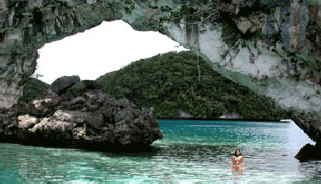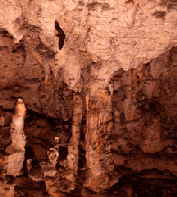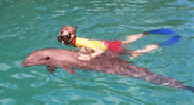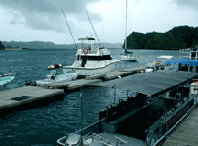|
Palau's Bountiful Beaches, Bubbles & Bats
By Larry Larsen
 It's called "paradise", and for outdoor lovers, Palau, a Micronesian island nation is. Located 800 miles southwest of Guam, Palau offers white sand
beaches, world-class scuba diving, and a variety of topography that includes caves, hills, lush forests, waterfalls and other natural beauty. Its barrier reef
shelters 66 miles of the country's length, providing a turquoise and sapphire lagoon, within which are found Palau's
greatest treasure, the beautiful Rock Islands. Consisting of 300 mushroom-shaped islands with limestone bases undercut by ocean currents and foliage-covered tops,
the Rock Islands are unique phenomena. Many of the uninhabited islets have secluded palm-lined beaches, caves and/or craggy arches. It's called "paradise", and for outdoor lovers, Palau, a Micronesian island nation is. Located 800 miles southwest of Guam, Palau offers white sand
beaches, world-class scuba diving, and a variety of topography that includes caves, hills, lush forests, waterfalls and other natural beauty. Its barrier reef
shelters 66 miles of the country's length, providing a turquoise and sapphire lagoon, within which are found Palau's
greatest treasure, the beautiful Rock Islands. Consisting of 300 mushroom-shaped islands with limestone bases undercut by ocean currents and foliage-covered tops,
the Rock Islands are unique phenomena. Many of the uninhabited islets have secluded palm-lined beaches, caves and/or craggy arches.
Outdoor lovers can enjoy the famous diving and snorkeling or partake in boating, rainforest trekking or hiking, spelunkering, biking, sailing, swimming, outrigger
canoeing, kayaking, beachcombing and picnicking, or bluewater game fishing. Renown diving in a beautiful underwater environment has put the Republic of Palau
on the tourism maps, but like most Western Pacific islands, there are many other "diversions" and excursions to enjoy. Only about 50,000 tourists visit remote 400
-mile-long archipelago each year and most get wet. Americans fly 9 hours from Hawaii to get away from the crowds and enjoy the pristine world beneath the gentle waves.
Scuba divers visiting Palau are in for a treat. Over 1400 species of fish and more than 700 species of coral and anemones are found in their clear waters. Jacques
Cousteau named Palau's Ngemelis Wall, commonly known as the "Big Drop-off", the world's best wall dive; it drops to nearly 1,000 feet, but its upper portion is
spectacularly colored with sea fans, sponges, coral whips and soft corals. Readers of several diving magazines have also ranked the island nation high in marine life,
visibility, wall diving and "big" animal encounters.
Palau offers 30 named sites as well as many lesser-known ones where divers can explore coral gardens, caves, plunging sea walls, and sunken World War II wrecks,
all encrusted with colorful, exotic sea life. Many of the sites are for advanced divers because of the strong currents. Palau's most popular dive site, Blue Corner, harbors
dogtooth tuna, resident Napoleon wrasses, wahoo, barracuda, gray reef sharks and other large fish that float along in the rapid currents. If you are very lucky, you
might see a large pelagic fish such as tuna, marlin, tiger shark or even an Orca.
 Near Blue Corner is German Channel, which is known for its regular sightings of manta rays and reef sharks. Siaes
Tunnel is an underwater cavern bathed in an ethereal blue light and peppered with sea fans and ancient bushes of black coral. On the white sand of this cavern, white-tip
reef sharks can almost always be found taking a snooze. Once through the tunnel, divers can explore the soft and hard coral threaded throughout a plunging wall. The
shallow Chandelier Caves are a series of underwater chambers filled with ancient stalactites. January through June is reportedly the very best weather for diving and for seeing fish action. Near Blue Corner is German Channel, which is known for its regular sightings of manta rays and reef sharks. Siaes
Tunnel is an underwater cavern bathed in an ethereal blue light and peppered with sea fans and ancient bushes of black coral. On the white sand of this cavern, white-tip
reef sharks can almost always be found taking a snooze. Once through the tunnel, divers can explore the soft and hard coral threaded throughout a plunging wall. The
shallow Chandelier Caves are a series of underwater chambers filled with ancient stalactites. January through June is reportedly the very best weather for diving and for seeing fish action.
After hearing about the schools of triggerfish, snapper, spadefish and barracuda, I had to experience the sea myself. I dove both the Big Drop-off and the German
Channel and viewed a variety of beautiful marine life, including baby lion fish, cleaner shrimp, cucumbers, plus several grouper, a couple of nurse shark and a white tip
reef shark among the corals. While I didn't see manta and eagle rays, I did sight a hawksbill turtles and the huge World War II ball and chain in the Channel that once
provided protection from unauthorized traffic through the channel.
|
Air, Accomodations and Activity Info
The Republic of Palau, a part of the Western Caroline Islands, is located in the Western Pacific, 4500 nautical miles
from Honolulu and 700 miles east of the Philippines. However, it is easily accessible via Continental Airlines flights from Newark, Houston or Los Angeles via Honolulu
with a brief stop in Guam. Visitors must have a valid passport to enter the country. To book travel, call Continental Airline Vacations at (800) 634-5555 (ext. 5) or visit
www.coolvacations.com.
For more information on the beautiful South Seas islands of Palau, contact the Palau Visitors Authority at PO Box 256,
Koror, Palau 96940, phone (680) 488-2793/1930, fax (680) 488-1453/1725, email pva@palaunet.com or visit www.visit-palau.com. For information on the Palau Pacific Resort,
write P.O. Box 308, Koror, Palau PW 96940, phone (680) 488-2600, email ppr@palaunet.com or visit their website at www.panpacific.com.
For watersports information including diving, kayaking, sportfishing and other activities,
contact Fish 'n Fins, P.O. Box 142, Koror, Palau 96940, phone (680) 488-2637, fax (680) 488-5418, email fishnfin@palaunet.com or visit www.fishnfins.com, and Sam's
Tours, PO Box 7076, Koror, Palau 96940, phone (680) 488-1062/5305, fax (680) 488-5003, email samstours@palaunet.com, or visit www.samstours.com. To find out more about Dolphins Pacific, email palau@dolphinspacific.com
or visit their website at www.dolphinspacific.com.
|
|
Snorkeling around the islands, for those visitors not SCUBA-certified, offers plenty of attractions and beauty. Sunken remains of more than 75 World War II military ships and
Japanese seaplanes and Zeros are scattered around the Rock Islands. Located primarily in the lagoons around the islands, these relics have developed their own ecosystem where
tropical fish, corals and other invertebrates not commonly seen along the outer reef systems thrive. There are acres of fringing coral reefs with colorful giant clams just feet below the
surface in virtually untouched areas, and some of the famous wall dives, such as Big Drop Off and Turtle Cove are spectacular for snorkelers since the walls descend right down from the surface.
Particularly fascinating is snorkeling in one of the world's natural phenomena's, Jellyfish Lake. In the isolated, land
-locked marine lake, sealed for millions of years from the open ocean yet fed saltwater by underground tunnels, the sealife has evolved into varied forms, the most evident of which are
the graceful jellyfish. Having been cut off from their natural predators for millions of years, the jellyfish no longer possess the venomous sting of their relatives in the open sea.
Thousands of them pulsate around the snorkeler, their bulbous crowns softly and harmlessly bumping legs, arms, and mask.
 One of the highlights to my recent trip to Palau was a visit to their newest attraction, Dolphins Pacific.
The world's largest dolphin research facility offers dolphin interaction opportunities in a natural setting nestled in a deep cove on the north side of
Ngeruktabel Island. It was there where I swam and dived with the dolphins, after shaking hands with them, getting a kiss from one, checking out their teeth, feeding them an imported
sardine and getting some information on the marine mammals from trained biologists and animal trainers. We petted the dolphin and held their fins while cavorting with them for 45 minutes. One of the highlights to my recent trip to Palau was a visit to their newest attraction, Dolphins Pacific.
The world's largest dolphin research facility offers dolphin interaction opportunities in a natural setting nestled in a deep cove on the north side of
Ngeruktabel Island. It was there where I swam and dived with the dolphins, after shaking hands with them, getting a kiss from one, checking out their teeth, feeding them an imported
sardine and getting some information on the marine mammals from trained biologists and animal trainers. We petted the dolphin and held their fins while cavorting with them for 45 minutes.
I swam with my arm around one for five minutes or more and then free-dived to the bottom 20 feet down. I looked over and my new "best friend" was be swimming right beside me.
Then I swam to the surface as fast I could propel myself with my scuba fins and the two of us "rocketed" straight up. I could only push about half of my body above the surface, and my
mimicking, but highly intelligent mammal friend, trying not to embarrass me by "jumping" higher, did the same. The 11 dolphin in the non-profit facility seem to genuinely love
entertaining and interacting with tourists. Dolphins Pacific is an experience not to be missed!
 Visitors can see the best of Palau underwater without getting their feet wet at the Palau International Coral Reef Center. This international research
facility located in Koror opened in 2001 with over a dozen aquarium exhibits and outdoor pools. They provide visitors fascinating insight into Palau's most unique creatures from the
diverse marine ecosystems and a view into mangrove, sea grass bed, inner reef, reef crest, outer reef and marine lake systems. Visitors can see the best of Palau underwater without getting their feet wet at the Palau International Coral Reef Center. This international research
facility located in Koror opened in 2001 with over a dozen aquarium exhibits and outdoor pools. They provide visitors fascinating insight into Palau's most unique creatures from the
diverse marine ecosystems and a view into mangrove, sea grass bed, inner reef, reef crest, outer reef and marine lake systems.
Kayaking, Sailing, Sport Fishing, & Land Tours
 Guided tours with sea kayaks or traditional Palauan outrigger canoes, called "kabekels" around the
magnificent backdrop of the Rock Islands are very popular. Quiet paddlers can navigate the labyrinth of the turquoise lagoon environment hugging the reef
-protecting emerald jungle islands. Exploring Mandarin Fish Lake where the unique and colorful fish is abundant is one stop that I enjoyed tremendously. Other tour
options include cruising 10 miles south of Koror to Ulong Island, Jellyfish Lake, Northern Babeldaob, Ngardmau Waterfall and the Palauan sunken village. Guided tours with sea kayaks or traditional Palauan outrigger canoes, called "kabekels" around the
magnificent backdrop of the Rock Islands are very popular. Quiet paddlers can navigate the labyrinth of the turquoise lagoon environment hugging the reef
-protecting emerald jungle islands. Exploring Mandarin Fish Lake where the unique and colorful fish is abundant is one stop that I enjoyed tremendously. Other tour
options include cruising 10 miles south of Koror to Ulong Island, Jellyfish Lake, Northern Babeldaob, Ngardmau Waterfall and the Palauan sunken village.
Sailing charters take guests out for the day or longer, silently cruising through the islands in search of one of many sandy cove anchorages where they may snorkel,
kayak or just enjoy lunch. More energetic sportsmen with powerboats can parasail effortlessly in the skies above the Rock Islands and have a panoramic view of the
shallow lagoons where schools of fish feed. They can also waterski and wakeboard or even do camping with various tour groups.
|
Island History and World War II
Palau played a significant role in World War II, and many relics of famous battles on
Peleliu and Anguar may be found, which are of great interest to visitors doing WWII History Tours. On many of the snorkeling trips, the sights are submerged Japanese
Zeros or other discarded war equipment. Japanese cannons on Babeldaob are among the attractions left in tack after the heavy bombings by Americans during 1944.
The German Light House Tour offers a mixture of land and sea time by combining calm water paddling and
canopy-covered hiking through the rock islands. Explorers visit Fantasy Lake then paddle to a natural lagoon to begin a jungle hike along a path constructed by the
Japanese during World War II. It leads to forgotten relics from the war such as secretive bunkers, massive cannons and caves and the rock island headquarters filled
with relics. At the top of the island is a century-old coral lighthouse constructed during the German occupation that allows for a birds-eye view of most of the
archipelago.
Spain governed the islands in the 1800's and passed them on to Germany. After their
defeat in World War I, the Germans passed the islands to Japan under the 1919 Treaty of Versailles. Then, following Japan's defeat in WWII, the Palau Island
District became a United Nations Trust Territory under U.S. administration. As part of its mandate, the U.S. was to improve Palau's infrastructure and educational
system in order for it to become a self-sufficient nation. In 1994, Palau gained its independence upon the signing of the Compact of Free Association with the United
States and became the 185th member of the United
Nations. Today, this democratic country is very stable.
|
|
Offshore from the islands, sportfishing charters afford visitors the opportunity to catch yellowfin tuna and wahoo year around or try for blue marlin from March
through December or dolphin or "mahi-mahi" as they are called in the Pacific during the months of December through April. Other species caught are
Spanish mackerel, giant trevallies and barracuda. Sam's International Anglers currently offers full- or half-day charters. While my short trip trolling aboard their
26-foot Seacat in the blue waters around the Rock Islands was too peaceful, the scenery along the outer reefs was exceptional. The boat is one of three they
offer that are fully equipped for sportfishing with outriggers and Penn International 30- and 50-weight reels. The crystal clear waters vary from almost neon
blue to turquoise green and all spectrums between.
Exploring nature's rich flora and fauna diversity on land is another option for visitors to Micronesia's westernmost island chain. In addition to native and
migrant species, like the saltwater crocodile, big land crabs and the leatherback turtle, there are eight endemic birds found only in Palau. Giant fruit bats are
the largest native terrestrial mammals, while dugongs (manatees) are rare and illusive residents of the mangrove swamp.
For those seeking relaxation with the comforts of home, resorts in the capital town of Koror provide white sand beaches, swimming pools and top-notch
restaurants. Over 2/3 of Palau's more than 17,000 people live on the island of Koror, and there are about 20 resorts and hotels and numerous restaurants
ranging from fine dining to moderately priced eateries. My accommodations at the beautiful 4-star Palau Pacific Resort were first class. The 64-acre garden
paradise with 160 spacious rooms has an extensive beach (the only one in Koror), activity center, two restaurants, swimming pool, tennis courts and a PADI diving facility.
One of Palau's most interesting attractions is the Ngardmau Waterfall, which is Micronesia's tallest.
Cascading into a small glade along a river flowing from Palau's tallest peak, 713-foot-high Mount Ngerchelechuus, the fall is a day hike rugged terrain. Hikers wade
through a river, making stops at the remains of a pre-war bauxite-mining railway and refreshing pools in the basalt riverbed. The Ngatpang Waterfall in the forested
Tabecheding River Valley near Koror is a popular retreat for locals and travelers alike.
Being an outdoors lover and not a big shopper, I found Palau to be a perfect "get
-away." The islands' natural beauty, untouched wilderness, culture and remoteness combine to offer something for adventure seekers, historical buffs, nature
enthusiasts as well as those who just want to get away from the rapid pace of their lives and soak up peace and tranquility. A trip to Palau may only last a week or two,
but the memories are sure to last a lifetime.
|